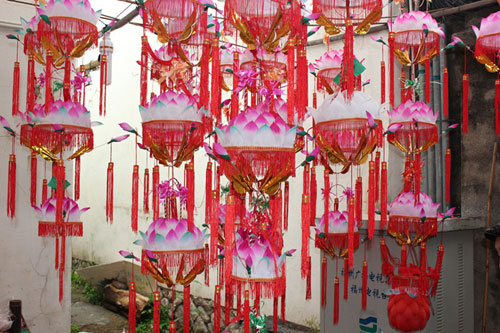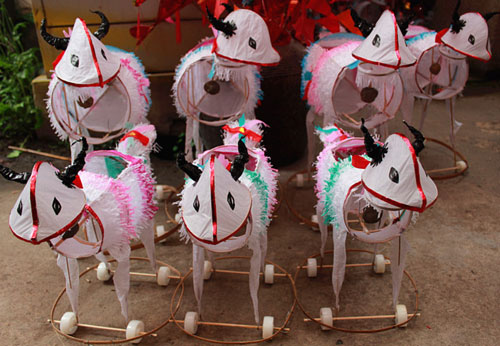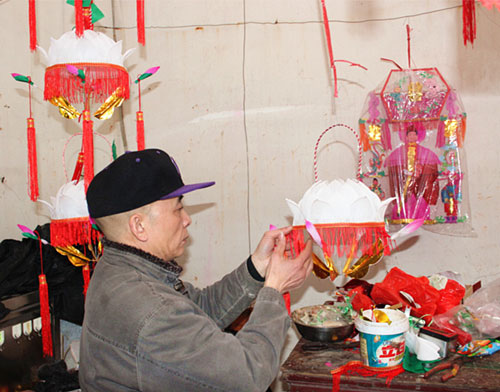At this year's Lantern Festival, the Queen's Palace in Sanfang Qixiang neighborhood, Fuzhou, capital of southeast China's Fujian province, not only saw a ceremony where lanterns were lit for blessing, but also invited the inheritors of intangible cultural heritage—Fuzhou lanterns—to teach children to make traditional lanterns.
History of Fuzhou Lantern Festival
The history of the Fuzhou Lantern Festival dates back to the Han Dynasty. In the Song Dynasty, they had become the choicest lanterns along with lanterns from Suzhou and Hangzhou during the lantern festivals in the capital.
When describing Fuzhou lanterns presented to the capital, the Tales of the Old Capital recorded that they were embedded with pure white jade, "eye-catching, like jade jars made of crystal ice, and very refreshing".
Legend has it that Fuzhou became a sea of faces at each Lantern Festival in past times. It blazed with lights. Trees glittering with lanterns were always a unique scene at the Lantern Festival.
 |
|
Traditional lotus lantern |
Fuzhou people loved strolling around the lantern market to enjoy the octagonal lantern, the ball lantern and the watermelon lantern, which were carried on a pole. The blade lantern and the dragons-struggling-for-a-pearl lantern to be shouldered. The monkey-on-a-sheep lantern, the cowboy-on-a-cow lantern and the Number One Scholar-on-a-horse lantern were walked on the ground. Palace lanterns and revolving lanterns were hung at home.
There was even a poem on the grand occasion of the Lantern Festival in Fuzhou. It reads, "When glittering lanterns are more and more, the Lantern Festival is coming. Colorful and splendidly-made, they are all for the New Year. They even light rooms and people drinking in the room with glimmers of light."
Customs of today's Fuzhou Lantern Festival
Two thousand years later, in the 21st century, Fuzhou residents, like other villagers in the Global Village, are concerned about the latest generation with their Apple phones; they are always busy burying their heads for news in their circle of friends, even when they are dining. However, they still remember the Lantern Festival and the lanterns.
It is said that tens of thousands of Fuzhou citizens took to the street before and after this Lantern Festival. People stopped and lingered around the "Never Ending" Lantern Festival.
From the exquisite lanterns in their hands, the giant theme lanterns that are more than 10 meters tall, to the cartoon lanterns designated especially for children, the Lantern Festival in Fuzhou this year really mixed the ancient with the modern, and interesting. The lanterns here are a touchable tradition and a scene of the golden age, too.
Fuzhou locals like sending people lanterns. In Fuzhou, special attention has to be paid to sending lanterns.
According to the old tradition, the first year after a girl gets married, her family would send a "Son Giving Goddess" lantern to her; the second year, it would be a "God Giving Children" lantern if the girl has not given birth to any child, or a "Baby in a Basin" lantern if the girl had given birth to any child; the third year, if the girl still has not had any child, it would be an orange lantern to indicate "eagerness." ("橘", orange, in English, sounds like "急", eager in English ).
After the girl gives birth to a baby, she would receive a "Number One Scholar-on-a-Horse" lantern or other toy lanterns that bless the baby with intelligence and health. There used to be a nursery rhyme among the people about the tradition of sending lanterns in Fuzhou. Sending lanterns is sending the blessing of "the more children, the more happiness."
 |
|
Xie Shanlin, 52, is a traditional lantern craftsman, who made lanterns in the shape of sheep - this year's Chinese zodiac animal. |
Traditional skills to make lanterns at risk of dying out
Nanhou Street, as the axis of the Sanfang Qixiang historical and cultural neighborhood in Fuzhou, used to be the biggest market for making and selling traditional lanterns in urban Fuzhou, and blazed with lights at each Spring Festival and Lantern Festival.
Traditional lantern craftsman Xie Shanlin lives in the depths of Huang Lane, Nanhou Street. The 52-year-old Xie learned to make lanterns from his grandmother when he was 10. He has been making lanterns for over 40 years. If the popular modern lanterns were "high-end, classy and high-grade," then the traditional lanterns Xie makes would be Fuzhou Qinghong wine—with complicated craft, becoming richer and mellower as time goes by.
Xie said that he had to start preparing materials in August, and made all the materials—from bamboo strips used to make the lantern frame and paper-cuts for the lanterns to tassel-like embellishments—by himself. In his eyes, each process is a study never to be treated sloppily. It takes three to four hours to make a small lantern, from the scheme of color, coloration and gloss to the addition of decorations; and an even longer time to make a big lantern.
 |
|
Traditional lantern craftsman Xie Shanlin makes lotus lanterns. |
Xie said that only a handful of craftsmen in Fuzhou now have truly mastered the craftsmanship of making lanterns and barely any young man wants to learn how to make them. Sticking to the art, Xie worries about the succession of the traditional craft.
"No matter what, these traditional lanterns are enriched by the folklore and are more environmentally friendly, which can never be replaced," Xie said.
A lantern represents the torrid and splendid modern life, and the memory of a tradition which has survived the vicissitudes of a millennium as well. The craftsmanship of traditional lanterns is a thread not to be broken in order to carry the tradition on.